
Radiant Silvergun is a shoot 'em up video game developed and published by Treasure. It was originally released in Japanese arcades in 1998 and subsequently ported to the Sega Saturn later that year. The story follows a team of fighter pilots in the far future who are battling waves of enemies summoned by a mysterious crystal dug up from the Earth. The player hosts an arsenal of six different types of shots to choose from, and a sword to destroy nearby targets. The stages are tightly designed to present players with scenarios that can be approached differently with the various weapon types.
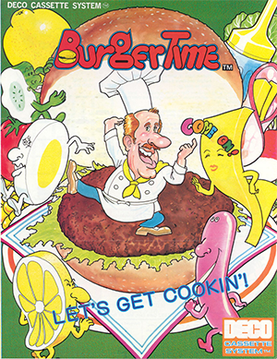
BurgerTime, originally released as Hamburger in Japan, is an arcade video game from Data East. It was published in 1982 for the DECO Cassette System. The player controls chef Peter Pepper who walks across oversized ingredients in a maze of platforms and ladders, causing them to fall and stack on buns below, eventually creating complete burgers. The chef is pursued by anthropomorphic hot dogs, fried eggs, and pickles. A limited supply of pepper can be thrown at aggressors immediately in front of Peter, briefly stunning them.
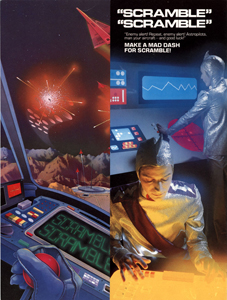
Scramble is a horizontally scrolling shooter arcade video game released in 1981. It was developed by Konami and manufactured and distributed by Leijac in Japan and Stern in North America. It was the first side-scrolling shooter with forced scrolling and multiple distinct levels, and it established the foundation for a new genre.

Spy Hunter is a vehicular combat game developed by Bally Midway and released for arcades in 1983. The game draws inspiration from the James Bond films and was originally supposed to carry the James Bond brand. The object of the game is to drive down roads in the technologically advanced "Interceptor" car and destroy various enemy vehicles with a variety of onboard weapons. Spy Hunter was produced in both sit-down and standard upright versions with the latter being more common. The game's controls consist of a steering wheel in the form of a futuristic aircraft-style yoke with several special-purpose buttons, a two-position stick shift, and a pedal used for acceleration.

Dig Dug is a maze arcade video game released by Namco in 1982. It was distributed in North America by Atari, Inc. The player digs underground tunnels to attack enemies in each level, by either inflating them to bursting or crushing them underneath rocks.

Tempest is a 1981 arcade video game by Atari, Inc., designed and programmed by Dave Theurer. It takes place on a three-dimensional surface divided into lanes, sometimes as a closed tube, and viewed from one end. The player controls a claw-shaped "blaster" that sits on the edge of the surface, snapping from segment to segment as a rotary knob is turned, and can fire blaster shots to destroy enemies and obstacles by pressing a button.
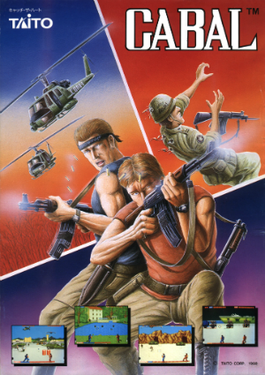
Cabal is a 1988 arcade shooter video game originally developed by TAD Corporation and published in Japan by Taito, in North America by Fabtek and in Europe by Capcom. In the game, the player controls a commando, viewed from behind, trying to destroy various enemy military bases. The game was innovative for the era, but only a mild success in the arcades, and became better known for its various home conversions.
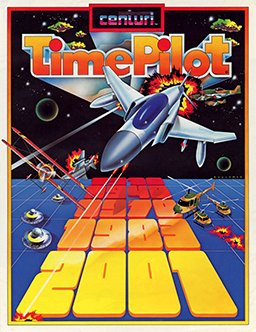
Time Pilot is a multidirectional shooter arcade video game designed by Yoshiki Okamoto and released by Konami in 1982. It was distributed in the United States by Centuri, and by Atari Ireland in Europe and the Middle East. While engaging in aerial combat, the player-controlled jet flies across open airspace that scrolls indefinitely in all directions. Each level is themed to a different time period. Home ports for the Atari 2600, MSX, and ColecoVision were released in 1983.

Salamander, retitled Life Force in North America and in the Japanese arcade re-release, is a scrolling shooter arcade video game developed and published by Konami. Released in 1986 as a spin-off of Gradius, Salamander introduced a simplified power-up system, two-player cooperative gameplay and both horizontally and vertically scrolling stages. Some of these later became normal for future Gradius games. In Japanese, the title is written using ateji, which are kanji used for spelling foreign words that has been supplanted in everyday use by katakana. Contra, another game by Konami was also given this treatment, with its title written in Japanese as 魂斗羅.

Rush'n Attack, also known as Green Beret in Japan and Europe, is a run-and-gun and hack-and-slash video game developed and released by Konami for arcades in 1985, and later converted to the Nintendo Entertainment System and home computers. Its North American title is a play on the phrase "Russian attack" due to its Cold War setting. It was ported to home systems and became a critical and commercial success for arcades and home computers.
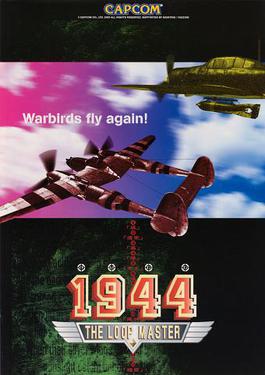
1944: The Loop Master is a vertical scrolling shooter scrolling arcade game made by Capcom in 2000 that uses a horizontal 4:3 screen. Unlike previous games, the programming for this arcade was done by a separate company called 8ing/Raizing. The game is the fifth of a series of World War II vertical shooters made by Capcom, the 194X series. The game takes place in the heated battles of 1944 during the Second World War as two super ace pilots, P-38 Lightning and Mitsubishi A6M Zero are attempting to defeat an entire army. It is the sequel to 19XX: The War Against Destiny and uses the arcade cabinet CP System II.

Jackal, also distributed under the title of Top Gunner, is an overhead run and gun video game released for arcades by Konami in 1986. The player must maneuver an armed jeep in order to rescue prisoners of war (POWs) trapped in enemy territory.

R-Type II is a horizontally scrolling shooter developed and published by Irem. It was released in arcades in 1989. It is the sequel to R-Type, and the second game in the R-Type series.

Forgotten Worlds, originally titled Lost Worlds, is a side-scrolling shooter video game by Capcom, originally released as a coin-operated arcade game in 1988. It is notable for being the first title released by Capcom for their CP System arcade game hardware.
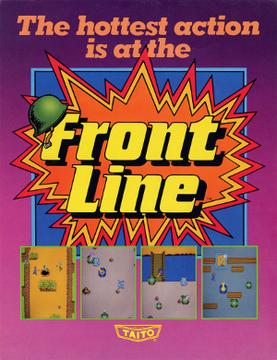
Front Line is a military-themed run and gun video game released by Taito for arcades in November 1982. It was one of the first overhead run and gun games, a precursor to many similarly-themed games of the mid-to-late 1980s. Front Line is controlled with a joystick, a single button, and a rotary dial that can be pushed in like a button. The single button is used to throw grenades and to enter and exit tanks, while the rotary dial aims and fires the player's gun.

Arkanoid: Revenge of Doh is an arcade game released by Taito in 1987 as a sequel to Arkanoid.

Section Z is a horizontally scrolling shooter by Capcom, released as an arcade video game in 1985. A home version was published for the Nintendo Entertainment System in 1987.

Zed Blade is a horizontally scrolling shooter arcade video game developed by NMK and originally published by SNK on September 13, 1994. It is the only game created by NMK for the Neo Geo arcade platform. In a science fiction setting, players choose one of three characters to attempt to overthrow an army of enemies led by the on-board supercomputer at the automated Yggdrasil space station and seize full control of it once again.
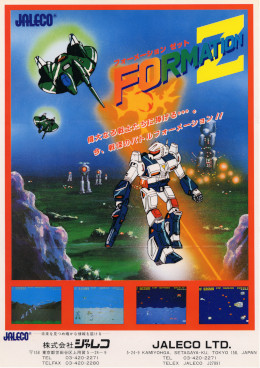
Formation Z is a 1984 horizontally scrolling shooter developed and published by Jaleco. The arcade release was distributed by Williams and known as Aeroboto outside Japan. It was later ported to the MSX and to the Famicom, the latter being included as part of Jaleco Collection Vol. 1 for the PlayStation. More recently the Famicom version of the game was made downloadable via the Wii's Virtual Console download service in Japan.

Rolling Thunder is a run and gun video game developed by Namco in Japan and Europe and released in 1986 as a coin-operated arcade video game using the Namco System 86 hardware. It was distributed in North America by Atari Games. The player takes control of a secret agent who must rescue his female partner from a terrorist organization. Rolling Thunder was a commercial success in arcades, and it was released for various home computer platforms in 1987 and the Nintendo Entertainment System in 1989. The original arcade game has been included in various classic game compilations as well. It influenced later arcade action franchises such as Shinobi and Time Crisis, which borrowed mechanics such as taking cover behind crates. On March 17, 2022, the arcade version of the game got ported as part of the Arcade Archives series.



















